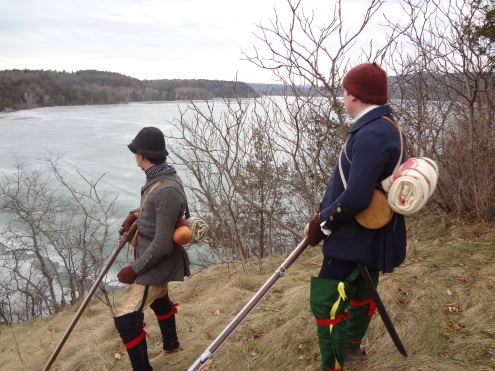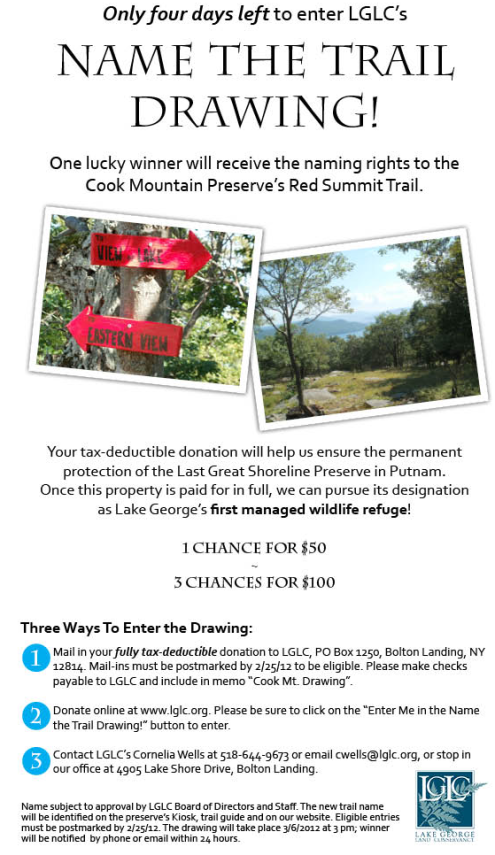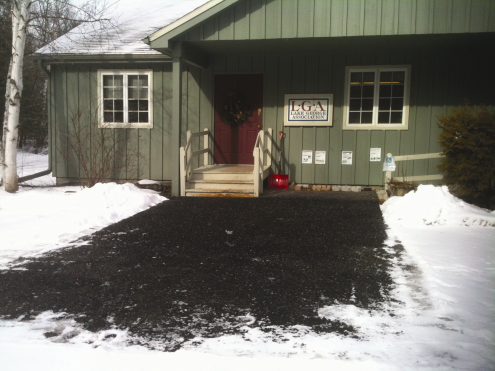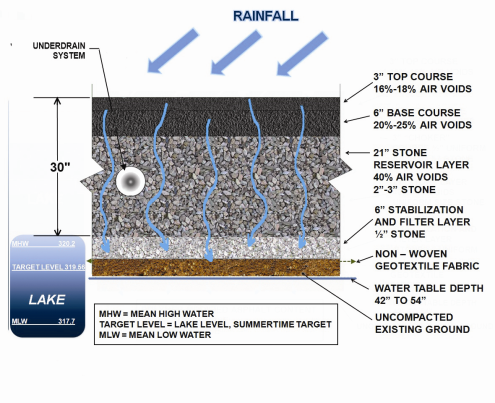
Recently, I had the opportunity to interview C. Walter Lender, the Executive Director of the Lake George Association.
“Walt” as he is known by many on Lake George, guides the day-to-day activities of the Lake George Association. Below is my interview with him.
The Lake George Association is known as the premier organization working to protect Lake George. Could you tell our readers a little bit about yourself, how you became involved with the LGA and what your role as Executive Director is?
I have spent my career in the not-for-profit world, and I have a background in fund-raising and administration. I have also lived on Lake George all my life and have been involved in environmental issues and land use planning. I have always been an advocate for protecting the Lake from years back when I would give neighbors a hard time about feeding the ducks or make a pointed comment to a boater flipping a cigarette butt into the Lake. When the LGA executive director position opened in 2004, I could think of no better opportunity than the chance to make a career out of protecting the place I love.
As the LGA’s executive director I lead a staff of professionals who are tasked with various roles in fulfilling the LGA’s mission. I do a fair amount of fund-raising and a good deal of administration and management. We have a very experienced group of staff members who manage our projects, provide our educational and outreach programs and services, develop our member and donor base, and get the word out about what we do. My role is to make sure that we are fulfilling our mission to the best of our ability, and that we have the funds we need to do that effectively and efficiently.
What are some of your favorite activities on Lake George?
I have always loved swimming in Lake George. I first came here as an infant and then every summer thereafter until moving here to Black Point in Ticonderoga year-round at age nine. I was always bewildered when swimming in other water bodies as to why I sometimes could not see the bottom, even when only waist deep. Lake George has always been the gold standard for water quality for me. I also love taking friends and family out on the Lake on our boat in the summer to enjoy the scenic beauty and tell stories about its history. Inevitably they fall in love as I have done. Now that my wife and I are raising a family here on the Lake, we enjoy taking our six little ones (yes, six) out to one of the islands in the Waltonian group near Hague for picnics. We haven’t attempted overnight camping there yet, but I’m sure we’ll try that out as they get a bit older. I have sailed on Lake George, canoed and kayaked, fished a bit, and even tried SCUBA, but I think I most enjoy just sitting on the shore at the end of the day in the summer watching our kids take one last swim before the sun drops behind Rogers Rock.

The Lender family relaxing on Lake George.
The Lake George Association is involved in a very big reclamation project, which I note is quite unique, in Lake George Village. Could you give some background on this project and explain where the project presently stands?
Much of what the LGA is doing right now is unique. The LGA is often the leader in finding ways to better protect the Lake’s water quality. If you are referring to the West Brook Conservation Initiative on the old Gaslight Village property in Lake George, it is perhaps the first of its kind in the Northeast. What makes it unique is the public-private partnership involved in making the project happen. Rarely do you see several different not-for-profit organizations and municipal governments working together on something of this scale. The project will divert and treat millions of gallons of polluted stormwater draining off one of the most developed areas in the Lake George watershed. The earthwork, contours, and infrastructure for the stormwater treatment complex on the south portion of the site are already in place, and we should see wetland plants installed in the spring. This area was historically a massive wetland at the mouth of West Brook at the southernmost tip of the Lake which naturally filtered the stream before it entered the Lake. One of the most fulfilling aspects of the project is that it is restoring a wetland area that was filled in generations ago when people did not understand how critical it was in protecting the Lake. Now, with an engineered design, it can go back to its role in protecting Lake George water from sediment, harmful nutrients, and other pollutants.
So if everything falls into place, when do you hope it will be completed and what should the public expect?
The wetland restoration aspect of the project should be completed in the summer of 2012 when it will begin to manage stormwater. But one of the best parts of this project is the fact that this whole, once-blighted property, where Gaslight Village used to be, will become a beautiful public park. The LGA secured a $2.5 million dollar Federal Transportation Enhancement Program grant to build a park on the property as an overlay to the stormwater management function. So while stormwater will be filtered and cleaned, the public will be able to walk on trails and boardwalks throughout the wetland areas, and the municipalities will have functional open space to hold special events. This larger project will take a bit longer. This winter, in response to much public input, the consultants will be finishing up the design and engineering documents for the park elements and it should go out to bid later this year for construction in 2013. I’m sure everyone will be pleased with the result. It will be a great asset for the greater Lake George community.
The LGA has been in the forefront of removing large delta’s that have formed in the lake. The FUND for Lake George, your partner in the West Brook Conservation Initiative, has a different point of view on delta removals. What should people make of all of this?
Yes, the debate over delta removal has certainly heated up recently. I agree with some of the points that the Fund and Waterkeeper programs have raised, and we have addressed their concerns. Many more groups, municipalities, and individuals support removing the deltas than oppose it. We have performed hundreds of thousands of dollars worth of remediation, retrofitting, and streambank stabilization in the watersheds of these streams. More areas of concern are also bound to come up in time. But we feel that it is time to remove certain deltas. Other streams might need more work before their deltas are removed. None of us wants to remove a delta and have it fill right back in. That would be impractical and not cost effective. We want to see these deltas removed in a way that we can be sure no harm is done to the Lake.
I know everyone loves Lake George, but for many Lake George is a second home and they’re not here all the time. How do suggest that regular “folks” who are not always here, help support your efforts?
Membership is key to our success. Our funding stream depends on dollars raised through Member dues. We need everyone who enjoys Lake George to have some part in protecting it for the next generations. That’s our collective responsibility. Those who came before us gave us a gift, and we need to pay it forward. The LGA was formed by its original members over 126 years ago largely because those who were not able to be here on the ground taking action and being vigilant relied on those few who were able to be present at the Lake. More folks are here year round than was the case in 1885, but it still takes a certain ability to focus on the issues and take action when we can. Not everyone can do that with today’s busy schedules, but the LGA is tasked with that responsibility. It’s our mission. We have a professional staff of year-round employees supplemented by summer Lake Stewards all of whom work to protect the Lake. Our greatest limitation is our funding. We need private and public funds to accomplish all the projects that we undertake and provide all the programs that we have developed. People can stay in touch with the LGA all year long and from anywhere in the world through our website, facebook, and e-news. Subscribe here: www.lakegeorgeassociation.org
While the summer is still a long way away, a lot of things happen here in the winter. Can you tell our readers how the LGA works to protect the lake during the cold winter months?
While there is no “down time” in any effort to protect such a precious resource as Lake George, the winter months see us shift gears from programs that take place outside on the Lake or along its shores to education programs in the classrooms, pre-development work (engineering, planning, and design) on upcoming stormwater projects, reporting on the past season’s activities, grant-writing and fund-raising. Your readers might be interested in the “Salmon in the Classroom” program that we are bringing to the Ticonderoga and Whitehall Central Schools. Perhaps they want to see the recently published results of the 2011 Lake Steward program. They may even want to hear about our recent work with the Lake George Elementary School. Our facebook page and website have the latest news.
Finally, I would be remiss if I didn’t ask how our readers can do something to help you?
I gather that most if not all of your readers are Lake George people, whether they live on or near the Lake or just visit. I’m sure that they love the Lake and want to protect it from all the threats that are out there. That’s what the LGA does, and we can’t do it without the help of our members. The LGA is the only membership organization protecting the Lake. Our members have been actively doing that since 1885. That’s a great legacy and one that everyone on the Lake should want to be part of. Your readers can join us through our website at www.lakegeorgeassociation.org.
What role do volunteers play in your efforts?
We have formal and informal volunteer opportunities here at the LGA. We are in the ninth year of our “citizen science” lake monitoring program through which volunteers commit to take water samples and collect water quality data. Our data is combined with data from other New York State lakes as part of the Citizens Statewide Lake Assessment Program (CSLAP). We have limited volunteer slots open for that program, but it is one way we involve volunteers. We also organize stream clean-up events, and trash removal after Log Bay Day or on the ice (when there is any.) We have involved volunteers on mailing projects and other office work, as well. And we always need volunteers for fund-raising events and activities. Our governing Board of Directors are also volunteers. Perhaps one of the best ways for people to volunteer is on one of our committees.
Thanks Walt for your time and for all you do for the “Queen of America’s Lakes.”
George, I’m very pleased to have this opportunity. I enjoy reading your blog. It’s very informative and well done. Keep up the great work!









